

The Mid-Winder
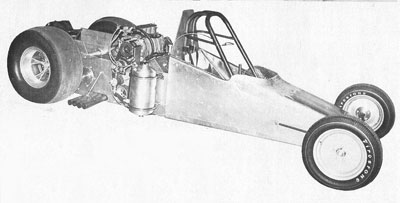
The chassis for Ed Lenarth's Mid-Winder Funny Car. A Gremlin body was going to be used, but the car crashed in testing minus the body.
|
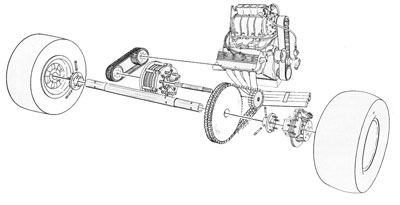
Lenarth's powertrain layout View bigger
|
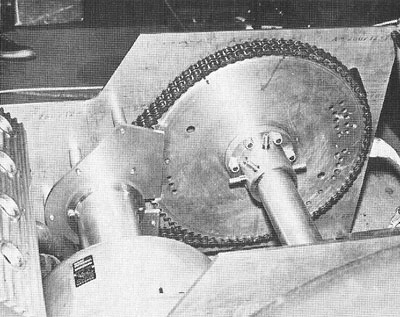 In this photo, you can see the clutch can in the lower left (adjacent to the valve cover, giving you an idea of proximity) and the large sprocket in the rear axle. |
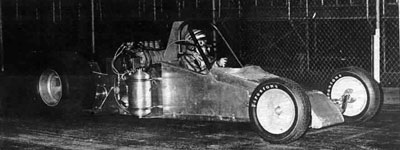
Bob Hightower crashed Lenarth's bodyless Mid-Winder at Lions.
(Jere Alhadeff photo) |
While Jack Chrisman’s better idea – a chain-driven sidewinder Mustang Funny Car – may endure in the NHRA history books because it provided John Force his introduction to the class, there was a similar car built at the same time whose place in the sport’s lore is not so memorable but that well deserves discussion here anyway as a “story behind the story.”
The man behind the plan was Ed Lenarth, whose impact on Southern California Funny Car racing in its nascent days is well-documented thanks to his popular Holy Toledo and Secret Weapon Jeeps. The drivetrain for Lenarth’s sidewinder – dubbed the Mid-Winder-- seemed extremely similar in design to that in Chrisman’s car: a sideways mounted Hemi, a clutch, and a Hy-Vo chain system, popular then on Detroit-built front-wheel-drive machines like the Oldsmobile Toronado and Cadillac Eldorado linked to a rear axle.
However, while it appears that Chrisman’s machine relied on just one chain, driven off the output shaft behind the clutch, drawings and photos of the Lenarth car appear to show a different, much more complex configuration, with one chain linked directly off a short output shaft that connected to a clutch that drove another aluminum shaft back across the width of the chassis to another chain set that drove the rear axle. The sprocket and wheels were attached to the tube axle with tapered pins. Note also that there was only one rear brake, on the right rear; because the axle is solid, like in a go-kart, and because the car was about 400 pounds lighter than a conventional car, Lenarth thought that this could work. I’m no engineer, so scope out the Tom West drawing at right that shows the design. Note also how Lenarth’s headers exited the side of the car – one bank on each side -- whereas Chrisman’s eight pipes all were routed out the rear of the car.
The other major difference was in body choice. Whereas Chrisman went the conventional route with a Mustang Mach I body, Lenarth opted for an outlandish AMC Gremlin body.
Lenarth, who had campaigned a mid-engine Modified Roadster in the 1960s, received some technical guidance from Ron Hamell at 10,000 RPM Engineering, who had built himself a chain-driven, DeSoto-powered car.
The bugaboo on Lenarth’s design was that because the first chain was between the engine and the clutch, the chain couldn’t be disengaged while the engine was running and had to operate at crankshaft speed, creating severe load that wore the aluminum pulleys and caused the chain to go out of adjustment. The pulleys were later anodized to harden them and slow the wear.
As it turns out, Lenarth never got to find out whether his design would work because Bob Hightower – who also famously crashed Doug Thorley’s rear-engine Javelin at Irwindale – repeated the feat with Lenarth’s car, crashing and damaging it at Lions Drag Strip.
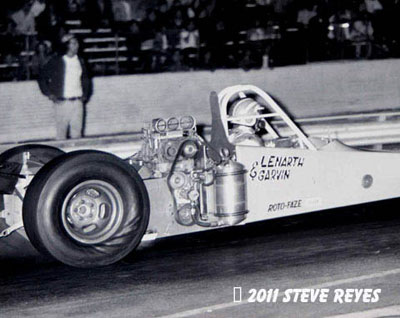 |
His pride battered but his spirit unbowed, Lenarth tried the sidewinder setup in a dragster, but it, too, reportedly crashed, at Irwindale.
“It staged and left the starting line hard and quick, then things went wrong, very wrong,” remembered Steve Reyes. “About 200 feet out, the car veered into the guardrail, then up and over the guardrail. The car twisted and rolled on the Irwindale fire-up road and rested up against the spectator fence.”
Lenarth retired from asphalt drag racing and went sand racing with one of his Jeeps. He later resurrected the Holy Toledo for nostalgia racing purposes (driven by James Day and others) before passing away earlier this year.



















































